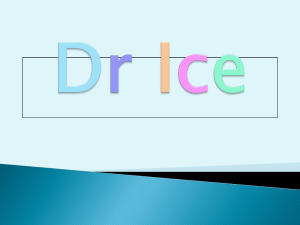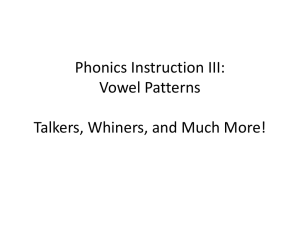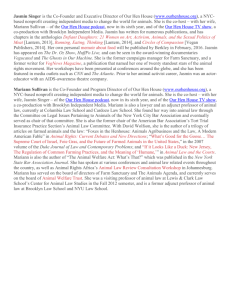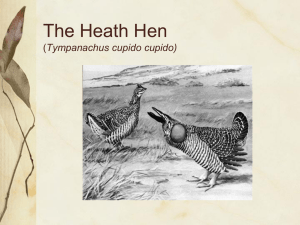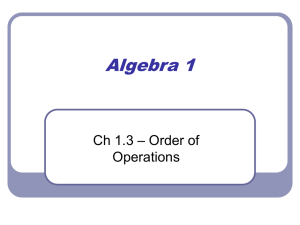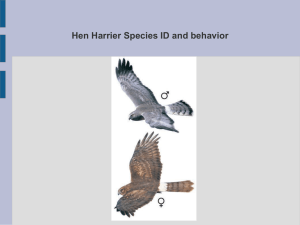Morphological Image Processing
advertisement
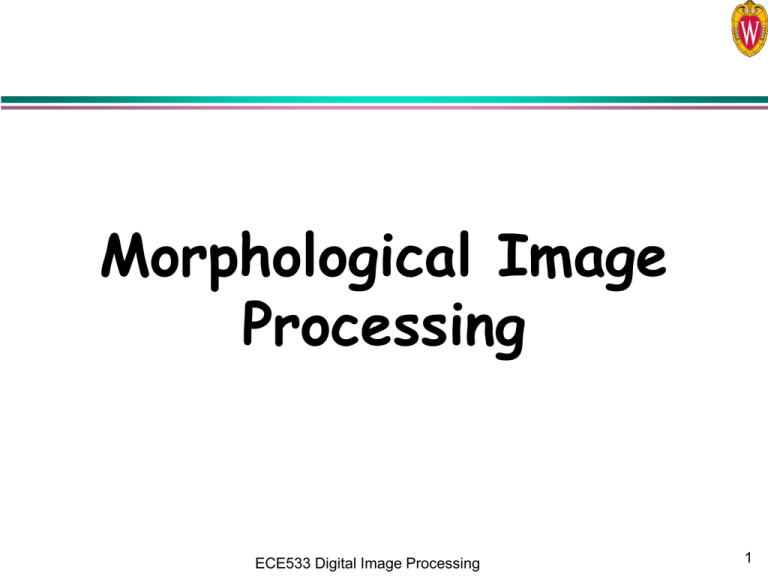
Morphological Image
Processing
ECE533 Digital Image Processing
1
Morphology
Morphology
» The branch of biology that deals with the form
and structure of organisms without
consideration of function
Mathematical Morphology
» Mathematical tool for processing shapes in
image, including boundaries, skeletons, convex
hulls, etc.
» Use of set theoretical approach
(c) 2003-2006 by Yu Hen Hu
ECE533 Digital Image Processing
2
Set Theory: Definitions and Notations
SET ()
» A collection of objects
(elements)
Subset ()
Empty set ()
(c) 2003-2006 by Yu Hen Hu
Union ()
» A B = {| A or B}
» Let A, B are two sets. If for
every a A, we also have a
B, then the set A is a subset
of B, that is, A B
» If A B and B A, then A =
B.
» If A , then its
complement set Ac = {|
, and A}
membership ()
» If is an element (member)
of a set , we write
Complement set
Intersection ()
» A B = {| A and B}
Set difference (-)
» B\A = B Ac
» Note that B-A A-B
Disjoint sets
» A and B are disjoint
(mutually exclusive) if A
B=
ECE533 Digital Image Processing
3
Set Relations
(c) 2003-2006 by Yu Hen Hu
ECE533 Digital Image Processing
4
Translation and Reflection
Translation (A)z = { c| c = a + z, for a A }
ˆ w | w b, for b B
Reflection: B
(c) 2003-2006 by Yu Hen Hu
ECE533 Digital Image Processing
5
Logic Operations Between Binary Images
(c) 2003-2006 by Yu Hen Hu
ECE533 Digital Image Processing
6
Dilation and Erosion
Dilation
B: structure element
A B z | Bˆ A
z | Bˆ A A
z
z
Erosion
A B = {z | (B)z A}
Relations
(A B)c = Ac Bˆ
(c) 2003-2006 by Yu Hen Hu
ECE533 Digital Image Processing
7
Example of Dilation
(c) 2003-2006 by Yu Hen Hu
ECE533 Digital Image Processing
8
Example of Erosion
(c) 2003-2006 by Yu Hen Hu
ECE533 Digital Image Processing
9
Opening
A B = (A B) B
(c) 2003-2006 by Yu Hen Hu
ECE533 Digital Image Processing
10
Closing
A B = (A B) B
(c) 2003-2006 by Yu Hen Hu
ECE533 Digital Image Processing
11
Example: Opening & Closing
(c) 2003-2006 by Yu Hen Hu
ECE533 Digital Image Processing
12
Finger Print Processing using Opening and
Closing
(c) 2003-2006 by Yu Hen Hu
ECE533 Digital Image Processing
13
Hit-or-Miss Transformation
for shape detection
(e)
A
(d)
Figure 9.12 (a) Set A, (b) A window W and the local
Background of X w.r.t. W, W-X. (c) Ac. (d) AX
Intersection of (d) and (e) shows the location
of the origin of X, as desired.
(c) 2003-2006 by Yu Hen Hu
ECE533 Digital Image Processing
14
Hit-or-Miss Transform
Denote B1: object, B2: local background of B1, then,
or
Reason to have a local background:
» Two or more objects are distinct only if they form
disjoint (disconnected) sets. This is guaranteed by
requiring that each object have at least a one-pixel-thick
background around it.
(c) 2003-2006 by Yu Hen Hu
ECE533 Digital Image Processing
15
Hit-or-Miss Transform
Previous example does
not contain don’t care
entries.
In structure element
» 1 – foreground
» 0 – background
» X – don’t care
Output is 1 if exact
match of both
foreground and
background pixels.
(c) 2003-2006 by Yu Hen Hu
Hitnmiss.m
» +1: foreground
» -1: background
» 0: don’t care
1 1 1 1 1 1 1
0 1 0 . * 1 1 1 0
1 1 1 1 1 1 1
1 1 1 1 1 1 1
0 1 0 . * 1 1 1 0
1 1 1 1 1 1 1
ECE533 Digital Image Processing
1 1
1 0 : match
1 1
1 1
1 0 : not match
1 1
Hitnmiss.m 16
Morphological Boundary Extraction
(A) = A − (A B)
(c) 2003-2006 by Yu Hen Hu
ECE533 Digital Image Processing
(9.5-1)
17
Example of Boundary Extraction
(c) 2003-2006 by Yu Hen Hu
ECE533 Digital Image Processing
18
Region Filling
X k X k 1 B Ac ;
k 1, 2, 3,
Y Xk A
(c) 2003-2006 by Yu Hen Hu
ECE533 Digital Image Processing
Fig915.m
19
Region Filling Example
(c) 2003-2006 by Yu Hen Hu
ECE533 Digital Image Processing
20
Connected Component Extraction
Y: connected component
in set A,
p: a known point in Y
X0 p
X k X k 1 B A
if X k X k 1
thenY X k
(c) 2003-2006 by Yu Hen Hu
ECE533 Digital Image Processing
Fig915.m
21
Thinning
A B A hitnm iss A, B
B B1 , B 2 , B n
A B A B1 B 2 B n
Thinning is often accomplished using
a sequence of rotated structuring
elements (a). Given a set A (b),
results of thinning with first element
is shown in (c), and the next 7
elements (d) – (i). There is no
change between 7th and 8th
elements, and no change after first 3
elements. Then it converges to a mconnectivity.
(c) 2003-2006 by Yu Hen Hu
ECE533 Digital Image Processing
Fig921.m
22
Thickening
AB = A hitnmiss(A,B)
A{B} =((…(AB1) B2) … Bn)
Thickening is the dual of thinning
operation. Usually, thickening a set
A is accomplished by thinning Ac,
and then complement the result.
Then a post-processing prunning
process is applied to remove
disconnected points as shown to
the left.
(c) 2003-2006 by Yu Hen Hu
ECE533 Digital Image Processing
23
Skeleton
A skeleton of a set A consists of
points z that is the center of a
maximum disk
A maximum disk is a circle in A
that can not be enclosed by
another circle that is also in A.
Figure 9.23. (a) set A, (b), (c) sets
of possible maximum disks. (d)
dotted line is the skeleton.
(c) 2003-2006 by Yu Hen Hu
ECE533 Digital Image Processing
24
Skeleton Equations
Define k consecutive erosions of A as:
AkB = ( …(AB)B) …)B) (9.5-13)
Sk(A) = (AkB) − (AkB)B
(9.5-12)
Let K = max{k | (AkB) }
(9.5-14)
Then the skeleton can be found as:
S ( A)
K
Sk ( A)
(9.5-11)
( Sk ( A) kB)
(9.5-15)
k 1
A
K
k 0
(c) 2003-2006 by Yu Hen Hu
ECE533 Digital Image Processing
25
Illustration of Skeleton Computation
Figure 9.24 Implementation of eq.
(9.5-11)-(9.5-15). The original set is
at the top left and its morphological
skeleton is at the bottom of the 4th
column. The reconstructed set is at
the bottom of the 6th column.
Define k consecutive erosions of A as:
AkB = ( …(AB)B) …)B)
(9.5-13)
Sk(A) = (AkB) − (AkB)B
(9.5-12)
Let K = max{k | (AkB) }
(9.5-14)
Then the skeleton can be found as:
S ( A)
K
Sk ( A)
(9.5-11)
( Sk ( A) kB)
(9.5-15)
k 1
A
K
k 0
(c) 2003-2006 by Yu Hen Hu
ECE533 Digital Image Processing
26
Pruning
(c) 2003-2006 by Yu Hen Hu
ECE533 Digital Image Processing
27

